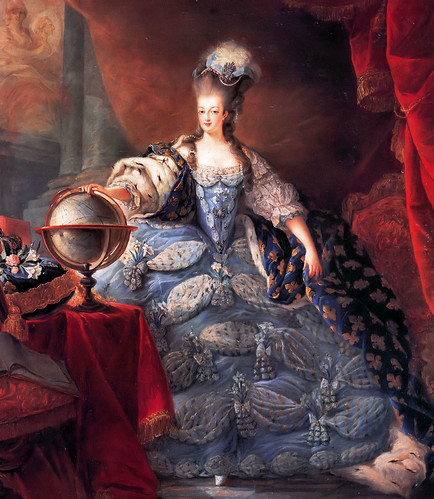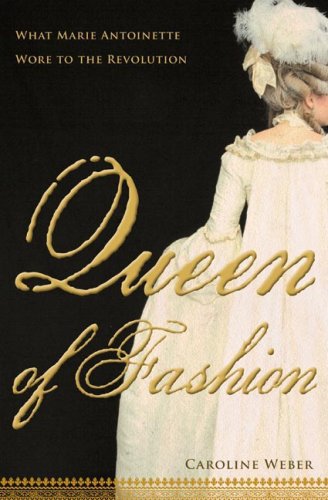Book Review: Queen of Fashion

Marie Antoinette often seems to be portrayed in one of two ways: she is either an immature bubbleheaded too obsessed with material pleasures to notice that her subjects were starving, or she is a doomed martyr, a scapegoat in the hands of murderous misogynists. Through her detailed examination of what the ill-fated queen chose to wear, Caroline Weber shows a much more nuanced picture in Queen of Fashion: What Marie Antoinette Wore to the Revolution.
In her time, Marie Antoinette was both a fashion icon and the subject of harsh ridicule for her sartorial choices, contributing to an increasingly hostile public perception and her eventual horrific demise. Just like women of fashion today, she was praised and emulated for her brave new looks, then torn down for her extravagance and scandalous attire. Caroline Weber shows how the queen played a fashion game that she loved, but ultimately could never win.

This is a beautifully written, well-researched and engaging book about every aspect of the queen’s attire, from her refusal to wear traditional and painful corsets, to her adoption of male riding attire, to the famous and controversial pastoral gaulle dress, pictured above.
One aspect that seemed particularly poignant to me is Weber’s assertion that the queen turned so wholeheartedly to fashion because she had so little actual power. With no formal power, a king who disregarded her opinions, and an inability to fulfill even her role as childbearer (thanks to the king), she endeavored instead to project an image of power. Clothing and hairstyle were something she did have control over, and they were used to make strong political statements about who she was and the type of power she wielded. It left me wondering how true this is for women today, turning to an almost obsessive love of clothing, shopping, maintaining self-image, and pining after more beautiful things because we feel powerless to control other aspects of our lives. What do you think?

Queen of Fashion paints a sympathetic portrait of Marie Antoinette, in which a woman uses fashion to express her identity at each stage of her life, both creating innovation and fueling a narcissism that helped lead to her (extremely tragic and horrible) death. For anyone interested in the political power of clothes, the incredible fashions of this era, or the life of Marie Antoinette, I highly recommend picking up this book!

 Sign In
Sign In


Comments
Andrea
December 21, 2010 #
This sounds like a great book! French queens had no real power at all, and were basically broodmares. And as you note, she was unable to fulfill even that role :/
Sarai
December 22, 2010 #
Yes, it astounds me that her very position as queen was threatened until she finally had a child.
Julie
December 21, 2010 #
Thanks for this review – it looks like an interesting book. I just ordered it from my library. :-)
Katrina
December 21, 2010 #
I can’t wait to pick this up! It’s so interesting to think that ‘powerful’ women like the queen might have turned to fashion as a way to control something in their lives.
Thanks for the recommendation!
melissa
December 22, 2010 #
ooh I read this book earlier this year! I agree – it was utterly fascinating and I learned SO much! I keep seeing her influence everywhere now after reading it, and I can’t wait to see some of the places mentioned in the book when we’re next in Paris this April…
Sarai
December 22, 2010 #
Yes, I think I will have a fresh perspective the next time I visit Paris and Versailles as well! I plan to read Antonia Fraser’s biography soon too. There were so many parallels in her life and her public image to today’s world.
Carolyn
January 3, 2011 #
I read this book a couple of years ago, and also very much enjoyed it. As a dress historian I have, however, a couple of cautions. While the book is obviously very thoroughly researched, I think the author gets a little…fanciful, or overly enthusiastic about some of her connections between Marie Antoinettes fashion choices and political repercussions. This is a tendency to which I can fully relate: when you have a great idea/direction you see connections EVERYWHERE, even when they’re tenuous or something else may be going on. However, that’s when a responsible researcher steps back and casts an objective eye over things. I think this objective perspective is sometimes lacking in the book.
Secondly, I wouldn’t use it as a guide for understanding the actual, physical pieces of clothing. As both an avid sewist and dress history scholar I just get a feeling that she doesn’t know much about garment construction (either past or present).
These comments are not meant to put anyone off of reading the book. I do think it is of value, and is very enjoyable. I just wouldn’t take it as gospel.
Sarai
January 3, 2011 #
Carolyn, thank you for your insightful comments. I don’t have the background to comment on your first point, but I do agree that there isn’t much construction detail in the book. That didn’t particularly bother me, though I can see how it might have enriched it in some ways.